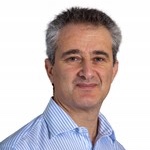- “Population precision medicine research in digital economy” by Nick Anderson
- “From detection to forecasting: Big Data and models in Epidemiology – The Example of Dengue in Rio de Janeiro” by Pierre Alexandre Bliman
- “Biomechanics and digital sciences to prevent risks of musculoskeletal disorders in elite sports practice” by Benoit Bideau
“Population precision medicine research in digital economy”Moderator: Thierry Priol Abstract: What might we expect in leveraging the near- ubiquitous availability of “small data” for precision health and medicine? Mobile health technology and patient provided data are relatively new arrivals into the already vast ecosystem of consumer provided social, environmental and behavior data. Despite a robust industry of personalized health monitoring devices and tools, as well as national and international precision health initiatives and patient outcomes research, there is limited acquisition and integration of personalized generated health data into patients clinical health states. Challenges in part are due to the unique and evolving intersection of broadly available commercial devices and new models of personal data ownership and services offered by companies, but also to limited methods of data quality and linkage that has potential clinical utility. Are there approaches from the broad public acceptance, use and sharing of personalized data in other environments that may enhance the capabilities to characterize patient health states? About the speaker: Dr. Anderson is Director of Informatics Research for UC Davis School of Medicine, Director of Informatics for the Clinical Translational Science Center at UC Davis, and the Cardiff Professor of Informatics in the Department of Public Health Sciences. His primary research interests are clinical research informatics data systems, data sharing policy and bioethics, and participant-centric tools. He is particularly interested in the development of sustainable, secure and scalable computing environments that allow for the application of data mining and modeling in integrative heterogeneous data sets that retain patient rights, intents, and sources of data provenance. |
“Biomechanics and digital sciences to prevent risks of musculoskeletal disorders in elite sports practice”Moderator: Jean-Frédéric Gerbeau Abstract: One of the main objectives in elite sports is to identify biomechanical parameters that are involved in the occurrence of traumas and musculoskeletal diseases. To this end, one has to evaluate joint constraints, such as joint torques and forces. Preliminary work has shown the relevance of studying these constraints thanks to inverse dynamics approaches. These works enables us to identify parameters that are supposed to be linked to musculoskeletal disorders. It could be applied to various physical activities, such as cycling on long distances or tennis serving. To fulfill the natural constraints of sports practice, one has also to consider fatigue. Indeed, long time competitions in tennis may affect the way the player perform tennis serve and consequently alter the associated joint constraints. In the same way, maintaining an efficient posture for a long time in cycling affects the cycling pattern and consequently produce asymmetrical motions which are considered as potential source of pathologies About the speaker: Benoit Bideau is associate professor in University Rennes 2, specialized in Biomechanics and new technologies applied to sports and human performance. He is the head of the M2S Lab “Motion, Sports and Health” in sports sciences in Rennes, and is member of the Inria MimeTIC team. His research works deal with kinematic and dynamic modelling of human motion, in order to identify criterions about human motion efficiency. A second objective consists in exploring the relationship between these criterions and the occurrence of musculoskeletal disorders. His research works also addressed the perception-action loop in duels in sports, using new technologies, such as virtual reality. He published several papers both in virtual reality, sports sciences, and biomechanics. |



